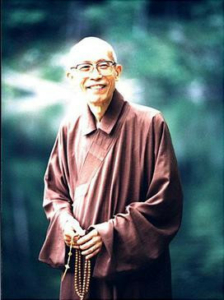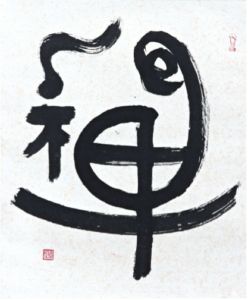Chan Teachings
For all those who would like to deepen their understanding of Buddhist teachings, we offer the course “Humanistic Buddhism – The Chan Teachings of Master Sheng Yen“. This comprises eight modules and extends over a period of four years. The courses take place monthly and can be attended in person on site or online. Further details can be found here.
The third course began in August 2022. Anyone interested in joining is welcome to contact us at info@chan-bern.ch.
The name Chan, from the Indian dhyāna, originally means meditation. In China it became the name of a school devoted primarily to meditative practice as a path to awakening.
After the Song period (960 – 1279), Chan was one of only two surviving Buddhist schools and partly mixed with the other school, Pure Land Buddhism. Thus, many monasteries in China were referred to as Chan monasteries, without this necessarily meaning that there was much meditation in these monasteries. From the middle of the 19th century, reform movements began and the resulting humanistic Buddhism was later brought into a form that corresponded to today’s times and scientific demands by Master Sheng Yen.
Humanistic Buddhism has become accepted as a name, the exact translation of the Chinese term ren sheng fo jiao (人生佛教) might be “Buddhism for those living in this world” or more freely “Buddhism for human beings”. This means for Master Sheng Yen to apply the Buddhadharma in ordinary, everyday life, thus serving the development of humanity in general.
Master Sheng Yen’s great achievement is that he has described the traditional meditation methods for us in such a way that they can also be used by laypeople (Huatou), and he has revived the lost method of Silent Illumination (Mozhao) and for made applicable to us. He promoted scientific Buddhist studies and prioritized their applicability to everyday life.
Like engaged Buddhism, humanistic Buddhism includes the involvement of lay people and women, everyday practice, social engagement and environmental protection.
Master Sheng Yen and his transmission lineage

Shifu Shengyen was born in 1930 and became a novice at 14 in Jiangsu. During the period of Communist unrest, he fled to Taiwan with the Nationalist Army. At 30 he became a monk again and spent six years in solitary retreat. Later on he studied in Japan and earned a doctorate in Buddhist literature from Rissho University in Tokyo. Afterwards he began to teach in the United States and followed his teacher in guiding the Nongcun Monastery in Taiwan. He also founded Dharma Drum Mountain (DDM). To promote Buddhist Studies and education of the monastics was a main concern of Shifu Shengyen. He established the Chung-Hwa Institute of Buddhist Studies and Dharma Drum University. In recent years he also engaged in public dialogues with leading figures in the fields of technology, art, and culture, and has collaborated with other religions.
Shifu Shengyen is a lineage holder of both Linji (Rinzai) (as a Dharma heir of Master Lingyuan) and Caodong (Soto) (as a Dharma heir of Master Dongchun). He has both strengthened the essence of Huatou Chan and revived the practice of Silent Illumination (Mozhao) in the Caodong Tradition. Dharma Drum Mountain (Fagushan) is an order of Chinese Humanistic Chan-Buddhism, founded in Indian Buddhism and inspired by Tibetan Buddhism. As in engaged Buddhism in the West, it combines individual practice with social engagement in the world and maintains several relief organisations.
Shifu Shengyen passed away on February 3, 2009.
A letter from the Abbot President on the death of Master Sheng Yen in English
What is Chan?
This is the transcript of a talk given by Master Sheng Yen in 1977, at the beginning of his teaching career in the US. It was originally published in a small pamphlet. While information in the article pertaining to lessons offered by the master is outdated, its overview of the essence of Chan practice is timeless.

Chan has universal and eternal existence. It has no need of any teacher to transmit it; what is transmitted by teachers is just the method by which one can personally experience this Chan.

Some people mistakenly understand Chan to be some kind of mysterious experience; others think that one can attain supernatural powers through the experience of Chan. Of course, the process of practicing Chan meditation may cause various kinds of strange occurrences on the level of mental and physical sensation; and also, through the practice of unifying body and mind, one may be able to attain the mental power to control or alter external things. But such phenomena, which are looked upon as mysteries of religion, are not the aim of Chan practice, because they can only satisfy one’s curiosity or megalomania, and cannot solve the actual problems of peoples lives.
Chan starts from the root of the problem. It does not start with the idea of conquering the external social and material environments, but starts with gaining thorough knowledge of one’s own self. The moment you know what your self is, this “I” that you now take to be yourself will simultaneously disappear. We call this new knowledge of the notion of self “enlightenment” or “seeing ones basic nature”. This is the beginning of helping you to thoroughly solve real problems. In the end, you will discover that you the individual, together with the whole of existence, are but one totality which cannot be divided.
Because you yourself have imperfections, you therefore feel the environment is imperfect. It is like a mirror with an uneven surface, the images reflected in it are also distorted. Or, it is like the surface of water disturbed by ripples, the moon reflected in it is irregular and unsettled. If the surface of the mirror is clear and smooth, or if the air on the surface of the water is still and the ripples calmed, then the reflection in the mirror and the moon in the water will be clear and exact. Therefore, from the point of view of Chan, the major cause of the pain and misfortune suffered by humanity is not the treacherous environment of the world in which we live, nor the dreadful society of humankind, but the fact that we have never been able to recognize our basic nature. So the method of Chan is not to direct us to evade reality, nor to shut our eyes like the African ostrich when enemies come, and bury our heads in the sand, thinking all problems are solved. Chan is not a self-hypnotizing idealism.
By the practice of Chan one can eliminate the “I”; not only the selfish, small “I”, but also the large “I”, which in philosophy is called “Truth” or “the Essence”. Only then is there absolute freedom. Thus an accomplished Chan practitioner never feels that any responsibility is a burden, nor does he feel the pressure that the conditions of life exert on people. He only feels that he is perpetually bringing the vitality of life into full activity. This is the expression of absolute freedom. Therefore the life of Chan is inevitably normal and positive, happy and open. The reason for this is that the practice of Chan will continually provide you with a means to excavate your precious mine of wisdom. The deeper the excavation, the higher the wisdom that is attained, until eventually you obtain all the wisdom of the entire universe. At that time, there is not a single thing in all of time and space that is not contained within the scope of your wisdom. At that stage wisdom becomes absolute; and since it is absolute, the term wisdom serves no further purpose. To be sure, at that stage the “I” that motivated you to pursue such things as fame, wealth and power, or to escape from suffering and danger, has completely disappeared. What is more, even the wisdom which eliminated your “I” becomes an unnecessary concept to you.
Of course, from the viewpoint of sudden enlightenment it is very easy for a Chan practitioner to reach this stage; nevertheless before reaching the gate of sudden enlightenment one must exert a great deal of effort on the journey. Otherwise the methods of Chan would be useless.

